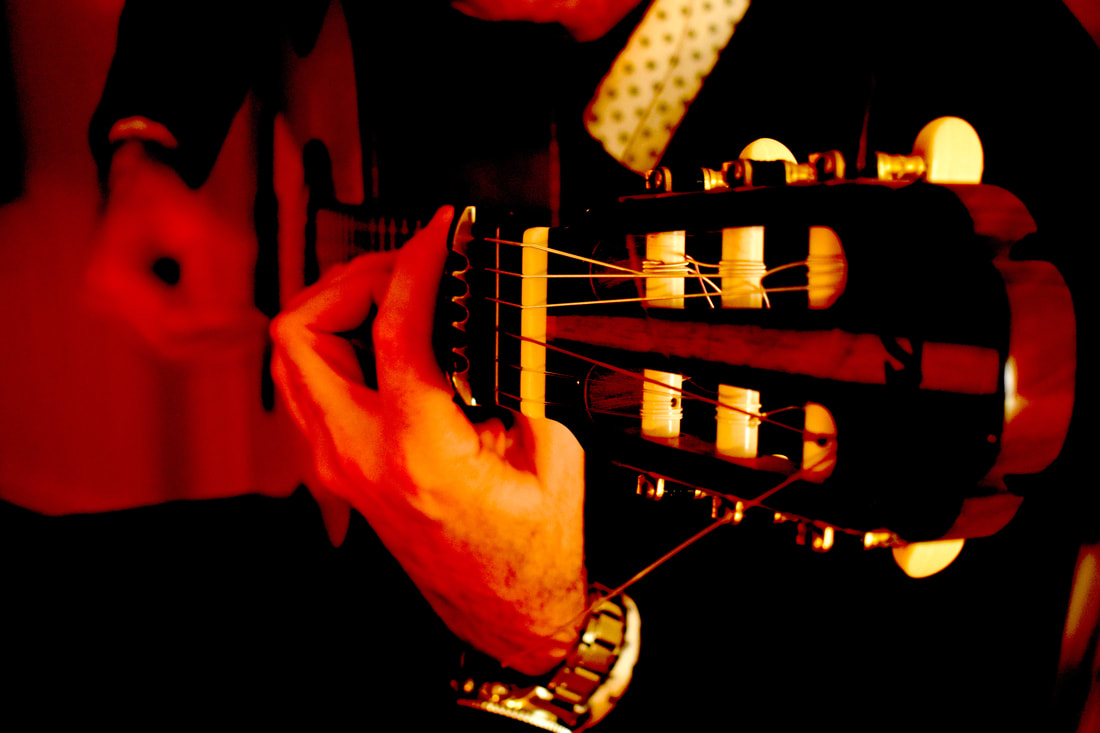What instruments are used in flamenco music?
Each 'palo' or style in flamenco guitar brings its own mood, from the lively bulerías to the haunting soleá. While the guitar can play alone, it is often rather part of an ensemble with percussive elements like the cajón and rhythmic hand claps known as palmas – accompanied by a singer.
These instruments create layers of sound, adding depth and intensity to the music. While traditional flamenco sticks to guitars, cajóns, and palmas, modern adaptations introduce electric guitars and bass guitars, blending tradition with contemporary flair. These instruments work together, evolving flamenco while preserving its essence. Let’s dive into each instrument’s role in shaping the captivating world of flamenco. But first, here’s a snapshot of how they sound when put together:
Guitar
The guitar in flamenco is the heart of the music. Its strings convey the essence of each palo, dictating the rhythm and mood. The percussive technique called "golpe" involves striking the guitar's body for added rhythm and intensity. The guitarist's skill lies in not just playing the notes but also in capturing the emotional depth of the music.
Cajon (drum)
The cajón, a wooden box drum, provides the percussive backbone. Players strike different areas to produce varied tones, adding a powerful beat that drives the music forward. Its simplicity contrasts with its significant impact on the overall sound.
Palmas (hand claps)
Palmas, or hand claps, are the organic rhythm section of flamenco. Performers create intricate rhythms by clapping in various patterns, complementing the guitar and cajón. Palmas contribute a raw energy that intensifies the emotional impact of the music.
Dancing (percussion)
Not strictly an instrument, but on a tableau (the wooden panel flamenco dancers traditionally dance on) makes a huge percussive sound similar to thunder.
Cante (singing)
Speaks for itself, often bringing joyful melodies in upbeat styles (known as palos) or more sorrowful ones (such as in solea).
Each instrument plays a crucial role, intertwining to create the vibrant tapestry of flamenco music. The guitar sets the melody and rhythm, the cajón drives the beat, and the palmas infuse the music with raw energy. Together, they form the backbone of flamenco, evolving with time while staying true to its passionate roots.
You can learn more about the sounds, history and musicality of flamenco music in Rafael's online course for guitarists.
Flamenco Instruments FAQ
What instruments are used in flamenco music?
Flamenco music typically features a blend of instruments including the guitar, cajón (a wooden box drum), and palmas (hand claps). Traditional setups often include singing (cante) and sometimes even dancing (on a tableau for added percussion). Modern adaptations might incorporate electric guitars and bass guitars, blending traditional flamenco with contemporary influences.
What role does the guitar play in flamenco music?
The guitar is central to flamenco music, dictating the rhythm and mood for each 'palo' or style. It not only produces melody but also adds percussive beats through techniques like 'golpe', where the guitarist strikes the body of the guitar to enhance rhythm and intensity.
How does the cajón contribute to flamenco music?
The cajón serves as the percussive backbone in flamenco music. It is a box-shaped drum that players strike in different areas to produce a variety of tones. These tones provide a powerful rhythmic foundation that propels the music forward.
What is the significance of palmas in flamenco?
Palmas, or hand claps, form the organic rhythm section in flamenco. Performers clap their hands in intricate patterns to complement the guitar and cajón, adding raw energy and enhancing the emotional depth of the performances.
Can dancing be considered a percussive element in flamenco?
Yes, in flamenco, dancing can be considered a percussive element. Dancers perform on a wooden panel called a 'tableau', which produces significant percussive sounds, akin to thunder, thus adding to the overall rhythmic impact of the performance.
How do the various flamenco instruments interact?
In flamenco, each instrument plays a vital role, intertwining to create a vibrant tapestry of sound. The guitar sets the melody and rhythm, the cajón drives the beat, and the palmas infuse the performance with raw energy. This combination, along with the emotional expression of cante and the percussive impact of dancing, forms the backbone of flamenco.
Where can I learn more about the sounds and history of flamenco music?
You can learn more about the sounds, history, and musicality of flamenco music through online courses such as Rafael's course for guitarists. These courses cover the fundamental and advanced techniques, instrument roles, and cultural context of flamenco.




